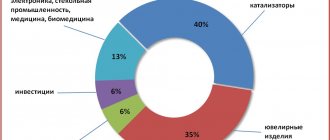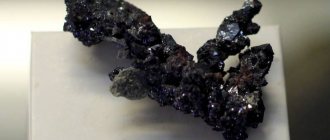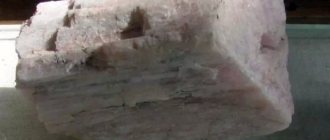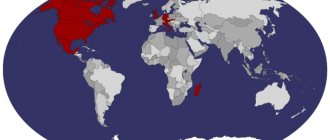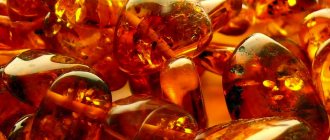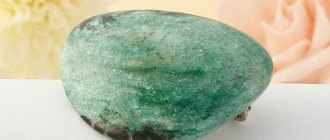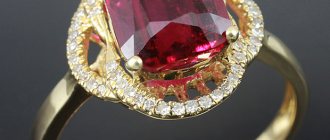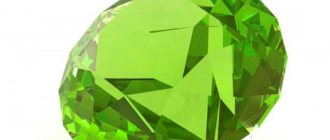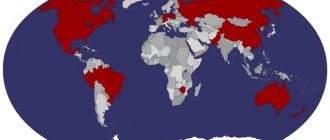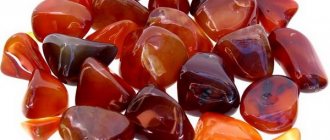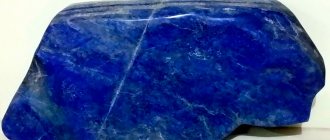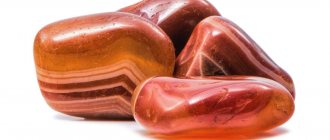Muscovite is a layered potassium silicate that belongs to the group of micas and is more commonly seen in the form of colorless white crystals. Sometimes, taking into account additional impurities, the mineral has a green, yellow, pinkish or brown tint. The muscovite stone has healing, magical properties, and also affects various signs of the Zodiac.
origin of name
The ancient Italian name of the city of Moscow is Musca. A transparent variety of the mineral, which was used instead of window glass, large sheets of muscovite, exported to the west through Moscow from “Muscovy”, were called Moscow glass.
Content
Muscovite cirrus (Mongolia)
- Chemical composition
- Varieties
- Crystallographic characteristics
- Form of being in nature
- Physical properties
- Chemical properties
- Diagnostic signs
- Origin of the mineral
- Place of Birth
- Practical use
- Physical research methods
- Crystal optical properties in thin preparations (sections)
- Buy muscovite
Chemical composition
Theoretical composition: potassium oxide (K2O) 11.8%, aluminum (Al2O3) 38.5%, silicon dioxide (SiO2) 45.2%, water (H2O) 4.5%.
Muscovite rich in Fe2O3 is called ferrimuscovite . Minor changes in the chemical composition give rise to a distinct zoning of muscovite crystals. There is no isomorphism between muscovite and biotite (or other trioctahedral mica), but due to the similarity of their structures, both minerals often intergrow with each other.
Varieties
- Sericite - Dense, fine-flaky light muscovite with a silky sheen. "serikos" in Greek is silky, possibly with a higher silica content, in which case it may be transitional to phengite K(Fe, Mg)Al[(Al,Si)Si3O10](OH, F)2. Chromium-containing phengite is called mariposite , and phengite with some Mn2+ and Mn3+ is called alurgite .
- Fuxite is a fine-flaky bright green (chromium-containing) muscovite. Cr2O3 up to 4.8%;
- Ellacherite - barium muscovite (K, Ba)(Al, Mg)2 [AlSi3O10](OH, F)2 With BaO up to 10%.
- Roscoelite is essentially vanadium muscovite with a V2O3 content of about 28%.
- Damurite is a partially hydrated muscovite or sericite, transitional to hydromicas.
- Gilbertite is a light yellow, fine-flaky muscovite of pegmatites and ore veins.
Crystallographic characteristics
M., lamellar aggregates with quartz and biotite (Inkutsk region)
Monoclinic syngony .
Symmetry class. Monoclinic-prismatic c. With. L2PC. Space group C2/c (C62h). a0 = 5.18; b0 = 9.02; c0 = 20.04; β = 95°30′. Axle ratio. 0.574 : 1 :2.221; (3 = 95°30′. The data refer to the most common polytype of dioctahedral micas 2M1. - 2/t s., p = 95c30, Z = 4, but muscovites of the lMd, 1M and ZT types are also known.
Crystal structure
Layered lattice.
Main forms : Pseudohexagonal muscovite crystals with forms c{001}, b{010}, m{110}, e{023}, y{043} and x{131} are common.
Serpentine formula
Mg6*(OH)8 or 3MgO 2SiO2 2H2O.
Chemical composition
MgO - 43.0%, SiO2 - 44.1%, H2O - 12.9%. The ratios of the components fluctuate somewhat, especially in differences similar to typical colloids, which are richer in water (usually up to 13–17%). Iron oxides FeO, Fe2O3 and nickel NiO are almost always present as impurities.
Varieties 1. Ophite (noble serpentine) - dense, translucent yellow-green serpentine with a waxy sheen at the edges. 2. Chrysotile asbestos is a fine-fibered light green, sometimes golden serpentine with a silky sheen.
Based on the subtle features of the crystal structure, which determine the nature of the overlay of layers and the width of the packets, several mineral types are distinguished. One of the most common mineral species of the serpentine group - monoclinic system, somewhat similar to chlorite in external characteristics, is called antigorite (in the Antigorio Valley, near Piedmont in Italy). Another polymorph, also layered in structure, is trigonal lizardite (from the town of Lizard in England). It is difficult to confidently distinguish these mineral species without special research, especially since they often form thin mixtures. Mixed-layer minerals are also known, in which layers of serpentine composition and structure alternate on a submicron scale with layers of talc or chlorite.
There are varieties containing Fe, Mn, Ni:
Nepuite is pure nickel antigorite Ni6Si4Oi0(OH)8, garnierite is nickel chrysotile.
Serpophyte is a dense variety of antigorite or mostly serpentine, carolite is similar to these but has a higher silica content (~50%) and low MgO (30%). Greenalite Fe6Si4Oi0(OH)8,
Kronstedtite Fe6(OH)8 and berthierine Fe6Si3Oi0](OH)8 correspond to some oxidized chlorites.
Grovesite is a manganese analogue of berthierine.
Amesite (Mg, Al)6(OH)8 is an analogue of corundophilite, but with single silicon-oxygen layers.
Crystallographic characteristics
Monoclinic system.
Symmetry class. Prismatic - Cm, C2 or C2/m). Axle ratio. — 0.6 : 1 : — 1.6; Р -92°. o, a0 = 5.30 5.34 A, b0 = 9.20 -f- 9.22 A, c0 = 7.46 -b- 14.65 A, p = 91°24′ - 93°16′, Z = 1 t- 2, respectively, for antigorite and chrysotile; Orthorhombic modifications are also known for both minerals.
Crystal structure
Layered. The crystal structure of all serpentines (including chrysotiles) is to a certain extent similar to the simple two-layer structure of kaolinite. The difference lies primarily in the fact that in serpentines the cations are concentrated in trioctahedral layers, in contrast to the dioctahedral layers in kaolinite packets. Further, the two-layer packets that make up the structure are characterized by the disproportion of trioctahedral “brucite” layers with hexagonal networks of silicon-oxygen tetrahedra. This disproportionality gives rise to the bending of the packets, which can maintain the direction of curvature in the case of uniform polarity in the direction of the vertices of the tetrahedrons, as occurs in chrysotiles, the structure of which turns out to be similar to tubes or rolls. In layered serpentines, the polarity of the networks periodically (in space) reverses, so that the structures alternate stripes composed of packets with differently directed vertices of tetrahedra, placed alternately on different sides of the trioctahedral cationic layer.
The elongation of the fibers coincides with the direction a. In addition to chrysotile with its inherent fibrous structure, all other representatives of serpentines, including antigorite, are found in the form of micro- and cryptocrystalline sheet aggregates. Most of them are colloidal or metacolloidal in nature.
Form of being in nature
The appearance of crystals . Regular tabular or lamellar, pseudohexagonal or diamond-shaped. Sometimes individuals with a columnar-pyramidal appearance are observed. The lateral edges are usually heavily streaked in horizontal directions.
Twins are common according to the mica law, rare according to the chlorite law.
Aggregates. Muscovite can also occur in continuous leafy-granular or scaly masses. Occasionally there are clusters of spherulites and kidney-shaped masses with concentric shell-like individuality. Solid, dense, hidden-scale masses with a silky sheen, sometimes difficult to recognize even under a microscope, are called sericite.
Physical properties of muscovite
Muscovite, crystal in pegmatite (Ilmensky)
Optical
- Color. In thin commissural leaves, colorless, silvery-white, gray, white, light yellow, light brown, greenish to brownish, often zonal. Rarely reddish tint. Fuchsite is bright green.
- Trait. White.
- Glass shine.
- The sheen on the cleavage planes is pearlescent, the dense scaly masses have a silky sheen, silvery.
- Transparency. Transparent, translucent.
The refractive indices are Ng = 1.588–1.615, Nm = 1.582–1.611 and Np = 1.552–1.572.
Mechanical
- Hardness. 2-3, elastic. The leaves of muscovite, like all minerals of the mica group, are flexible and elastic when bent; varieties are known that are transitional to brittle micas and, conversely, close to talc-like.
- Density 2.76-3.10 increases with increasing iron content (for roscoelite - 2.97).
- Cleavage is very perfect along {001}, imperfect along {110} and {010}, which are slip planes
- The fracture is stepped or uneven. The mineral is flexible and splits into leaves.
Chemical properties
Behavior in acids. It does not dissolve; at temperatures above 850 °C, water loss occurs.
Other properties . Individual leaves are flexible and elastic. Muscovite is an excellent insulator for electric currents of ordinary voltage and has a fairly high breakdown resistance.
Diagnostic signs
Muscovite transparent crystals
Similar minerals. Paragonite (sodium-aluminum mica, or sodium muscovite), phlogopite, biotite, talc, Maryino glass (transparent spar-like gypsum).
It is easily recognized by its external characteristics: light color, pearlescent or silvery sheen, very perfect cleavage and easy splitting into thin transparent elastic leaves. It differs from phlogopite in optical constants, mainly in the angle of the optical axes (in phlogopite it is very small).
It is similar to talc, but is not greasy to the touch and its scales (leaves) are flexible and elastic.
Associated minerals. Quartz, feldspars (orthoclase, oligoclase), calcite, apatite, biotite, hornblende, garnet (almandine), staurolite, kyanite, chloritoid, tourmaline, etc.
Origin and location
A common, chemically stable mineral.
Among the minerals of the mica group, it is widely distributed. As a rock-forming mineral, it is included in the composition of some intrusive rocks , in particular, in the composition of granites, especially greisen, i.e., pneumatolytically altered varieties of them, in association with topaz, lithium mica, quartz, sometimes wolframite, cassiterite, molybdenite, etc. In these cases, muscovite is formed mainly due to previously released potassium feldspars (orthoclase and microcline).
Relatively often found in granite pegmatite veins in the form of large crystals of industrial interest. Muscovite in such veins, especially in the central parts, often produces clusters in the form of nests up to 1–2 m in diameter, but is usually randomly scattered in the form of large crystals throughout the entire mass of pegmatite or along certain zones.
Zircon, rutile in the form of a saguenite lattice, apatite, spinel, garnets, tourmaline, quartz, magnetite, etc. are sometimes found as tiny inclusions in muscovite crystals. With a detailed study, in some cases, it is possible to establish certain patterns of orientation of these inclusions in accordance with the structural features of the minerals.
in contact-metasomatic deposits. There are known cases of the formation of fine-grained muscovite in sandstones at their contact with granites and other acidic igneous rocks.
Under hydrothermal conditions, sericite is usually formed due to the decomposition of spars (sericitization, i.e. the formation of sericite - a cryptocrystalline variety of mica enriched in water): 6KAlSi3O8 + 4H2O + CO2 + ZAl2O3 -> 4KAl2[AlSi3Oi0](OH)2 + K2CO3 + 6SiO2. Sericite is stable in neutral (weakly acidic or slightly alkaline) solutions at relatively high temperatures, while in more acidic solutions pyrophyllite and kaolinite are formed instead; the latter is a lower temperature mineral.
In metamorphic rocks, muscovite and sericite are widespread. Entire massifs of mica crystalline schists, sericite-containing shales (phyllites) and quartzites with muscovite are known. In such rocks, feldspars are usually absent, because being the initial source for the formation of muscovite micas under conditions of regional metamorphism.
During weathering processes it is relatively chemically resistant and often turns into placers. Due to its ability to easily split into small leaves and due to its low specific gravity, it usually accumulates in the form of tiny silvery sparkles in silty sediments and layered clays formed in water basins with slow water movement.
Under conditions of intense chemical weathering, muscovite is capable of transforming into hydromicas richer in water - hydromuscovite, and when passing into an alkali solution - into kaolinite.
Disadvantages of the breed
As mentioned earlier, mica is a mineral that can impart significant strength to a material. However, despite its highly valued properties of versatility and practicality, this rock is characterized by porosity and fragility. That is why mica is used exclusively in combination with other components that can provide the material with solidity and mechanical strength. The presence of this mineral in rocks reduces their durability and strength, making grinding and polishing difficult.
Place of Birth
Of the numerous mineral deposits, we will indicate only the most interesting, widespread in pegmatites.
In the north-west of the European part of Russia there was an ancient mica trade. Deposits in Karelia were known back in the 15th century. Mica-bearing pegmatite deposits are located among granites, gneisses, mica schists and other metamorphic rocks. Muscovite is associated with feldspars, quartz, and to a lesser extent with schorl, apatite and other minerals.
Mica deposits are common in the Mamsky region of Eastern Siberia. A wide mica-bearing strip of metamorphic schists is bounded by granite massifs in the northwest and southeast. Crystals of muscovite (sometimes up to 50 cm) with a reddish or yellow-greenish tint are observed in paragenesis with acidic plagioclase, microcline, quartz, biotite, in some cases with black tourmaline, apatite, garnet, etc. Mica is completely transparent, easily splits into thin sheets with a smooth surface. smooth surface.
The main foreign deposits of muscovite in pegmatites are located in India (Bengal and Madras regions), where muscovite crystals up to 3–5 m2 or more are found; in a number of US states (North Carolina, Maryland, etc.); in Brazil, Canada, East Africa; Australia; Norway and other deposits.
In Germany, M. is widespread in the Ore Mountains (Fichtel Mountains), in the Saxon Granulite Mountains (schist cover), in the area between Hohenstein-Ernstthal and Karl-Marx-Stadt (Langenberg Heights), along the western edge of the Thuringian Forest near Rula, between Riesa and Meissen, Nosean, Siebenlen and other places. Here, fine-scaled muscovite (sericite) is associated with phyllites.
Stone products
Muscovite is used for jewelry. Bracelets, beads, pendants, earrings, rings, and rings are made with gemstones. Leather, wood, jewelry alloy or precious metal are used for the frame.
They wear jewelry with clothes whose style is in harmony with the design of the product. They are not worn in the gym, on the beach, in the pool, or in the sauna. Clean with water and a soft brush. Store in a fabric bag or case.
A raw mineral measuring 3–5 cm costs from $2. Collectible samples of muscovite paired with another gem are sold for 2,000–120,000 rubles. Prices for jewelry range from 20–200 euros/1 item.
How to care for a mineral
Products made from mica are quite fragile, so they must be protected from impacts and friction. It is better to store jewelry in separate boxes with a soft backing. Do not get it wet or leave it in the bath or damp places. To remove dirt, wipe with a damp cloth and immediately blot with a paper napkin. Dust is brushed off with a synthetic broom.
Practical use
About 90% of muscovite is used as a dielectric in the electrical industry, radio engineering and instrument making. Mica powder (scrap) - for the production of fire-resistant building materials, wallpaper, paper, paints, etc.
The most important practical property of muscovite, as well as phlogopite, is its high electrical insulating qualities. In industry, mica is used in the form of mica sheets, mica powder and various mica products.
The most valuable sheet mica is used mainly in the electrical industry: for insulators, capacitors, rheostats, telephones, magnetos, electric lamps, kerosene stoves, mica glasses and other purposes. Depending on the size of the plates, the degree of their transparency and uniformity of color, several varieties of sheet mica are distinguished.
Mica powder (scrap), obtained by grinding waste from cutting mica sheets, is used in the manufacture of fire-resistant materials (roofing felt), wallpaper, writing paper, mica cardboard, fire-resistant paints, brocade paints, various ceramic products, car tires, for explosives ( as an adsorbent), lubricants, as thermal insulation in steam boilers, etc.
Mica fabricates, mainly micanite, are used as substitutes for mica sheets in cases of less critical applications (for electrical insulating gaskets in some electrical appliances: electric kettles, saucepans, irons, etc.). Micanite is made from small mica leaves and scraps obtained in the form of residues when using sheet grade mica, by gluing them with shellac and subsequent pressing under high pressure.
Areas of use
The use of biotite is due to its physicochemical properties. It weathers easily, losing its flexibility. The plates simply fall apart. But this flaw is compensated by other beneficial properties of the stone.
Industry
The mineral is in demand in many industries:
- Chemistry. Powdered biotite is a component of refractories, enamels, and paints. Biotite chips add a golden shine to paint or polymer. It makes the painted surface look brilliantly impressive.
- Electrical and radio engineering. Mica paper or mineral insulating tape is endowed with exceptional electrical insulating characteristics that are not affected by temperature or humidity.
- Optics. Optics manufacturers value the material for its high birefringence index.
- Use in construction. Biotite is used as a component of vermiculite - a filler for sound and thermal insulation. It makes a decorative facing material (cement plus a generous portion of mica).
- Agriculture. The structure of the mineral ensures good ion exchange. Therefore, it becomes a natural fertilizer rich in microelements.
- Cosmetics industry. The finely dispersed mineral turns into a pearlescent additive for products such as eye shadow, lipstick, and powder.
As you can see, biotite is important as a raw material, component, auxiliary material. It is not suitable for leading roles due to its low hardness and fragility.
Jewelry
Jewelers are not too fond of this ornamental gem. Large companies do not use it; this is a segment of single craftsmen.
Product range: pendants, pendants, beads, bracelets. Almost always their insert is a cabochon. It is framed with silver, jewelry alloy, cupronickel.
The discreet range of the mineral allows men and women to wear jewelry to the office. It is appreciated by representatives of subcultures. For children or youth, this is more of a talisman.
Collecting
For collectors of mineralogical collections it is of special importance.
Samples combining biotites with other minerals can take years to collect. A variety of forms (plates, crystals, ovals), deposits, and colors of biotite create the prerequisites for replenishing the collection.
The science
The mineral is of particular importance for scientists: it is a very accurate geological “clock”.
Biotite “accumulates” information about processes that took place millions of years ago. Its layered structure records changes in climate, atmospheric composition, and other external parameters. By studying the mineral using the isotope method, science determines the geological age of the rocks.
Physical research methods
Differential thermal analysis . The DTA curve of muscovite shows three endothermic peaks at temperatures around 125, 860 and 1180° and one exothermic at 377°; the latter is caused by the oxidation of divalent iron.
Main lines on X-ray diffraction patterns : 10.04(10) - 5.02(5) - 4.48(6) - 4.46(5) - 3.35(10) - 2.56(8) (muscovite 2M1) ; 10.08(10) - 4.49(8) - 3.36(10) - 3.07(5) - 2.58(5) - 2.56(8) (muscovite 1M); 9.99(10) - 4.99(8) - 3.33(10) - 2.56(5) (muscovite 3T).
Ancient methods. It melts with difficulty under a blowpipe; in this case, a gray or yellow glass pearl is formed - white enamel. Water begins to be released only at a red-hot temperature (above 850 °C).
Interference coloring in thin section
Emergence
There are a number of methods for the appearance of muscovite:
Magical emergence. The mineral is found in vein layers of igneous origin. And this is by no means formed in the flowing layers. Subsequently, the freezing of medium and acidic magmas accentuates the mineral. It is considered a rock-forming component of some of the upper layers (roughly granite). Then the mineral begins to spread throughout the entire space of the pegmatite (the reproduction sphere of the “main” layer) or is folded into a nest (they can reach 1.5-2 m).
Metamorphic emergence. With an intrusive combination (mineral concentration of high igneous layers formed in the depths of the earth's strata) and upper layers.
In layered clays and clayey sediments. They arrive there as a result of the formation of extinction. Under the influence of wind, small inclusions of muscovite in exposed areas exfoliate and disintegrate into small particles. If the disappearance is chemical, the mineral can switch to other substances.
Crystal optical properties in thin preparations (sections)
Muscovite is colorless. Fuchsite is green, roscoelite is dark green to dark brownish with distinct pleochroism and normal absorption: Ng > Nm > Np. ng = 1.588 4- 1.624, nm = 1.582 - 1.619, np = 1.552 - 1.570, higher for roscoelite (ng = 1.704, nm = 1.685, np = 1.615). (—)2V = 35 H - 50°, phengite has less (10 - 25°); mariposite and alurgite are almost uniaxial. The plane of the optical axes is perpendicular to (010), Np is almost J_ (001), but for three-layer mica with c0 = 30.40 A and p ~ 90° (C2 symmetry), the plane of the optical axes is parallel to (010), (—)2V = 15° .
Muscovite under a microscope in transmitted light
